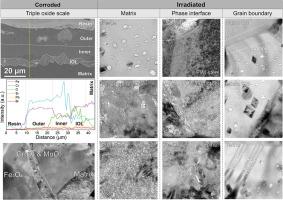In-situ study on the differential evolution of He bubbles in the multilayer oxide of Fe9Cr1.5W0.4Si F/M steel corroded in lead-bismuth eutectic
IF 2.8
2区 工程技术
Q3 MATERIALS SCIENCE, MULTIDISCIPLINARY
引用次数: 0
Abstract
The combined effects of corrosion and irradiation on nuclear components have been an important but not yet fully revealed topic. Here, the irradiation behavior of the oxide scale formed on F/M steel after lead-bismuth corrosion was in-situ investigated during He+ irradiation. The results showed that the oxide scale included a Fe3O4 outer oxide layer, a nanograin Fe(FexCr2-x)O4 spinel inner oxide layer, and an internal oxide layer. He bubbles formed in Fe3O4, Fe-Cr spinel and F/M steel were polygon, irregular elongated pores and small spheres, respectively. These differences were attributed to variations in defect generation, migration, and corrosion-induced crystal defects in different oxides. Numerous corrosion-induced nanograin boundaries and vacancies in Fe-Cr spinel exhibited more effective absorption of irradiation-induced defects. Moreover, rhombic perfect dislocation loops were detected in Fe3O4 at the late stage of irradiation, their relative positional relationship with He bubbles indicated a potential interaction between bubbles and loops.

铅铋共晶中腐蚀的 Fe9Cr1.5W0.4Si F/M 钢多层氧化物中 He 气泡差异演化的原位研究
腐蚀和辐照对核部件的综合影响一直是一个重要但尚未完全揭示的课题。在此,我们对铅铋腐蚀后在 F/M 钢上形成的氧化鳞在 He+ 辐照下的辐照行为进行了原位研究。结果表明,氧化鳞包括外氧化层 Fe3O4、纳米晶粒 Fe(FexCr2-x)O4 尖晶石内氧化层和内部氧化层。在 Fe3O4、Fe-Cr 尖晶石和 F/M 钢中形成的 He 气泡分别为多边形、不规则细长孔隙和小球形。这些差异归因于不同氧化物中缺陷生成、迁移和腐蚀诱导晶体缺陷的变化。铁铬尖晶石中大量的腐蚀诱导纳米晶界和空位对辐照诱导缺陷的吸收更为有效。此外,在辐照后期,在 Fe3O4 中检测到菱形完美位错环,它们与 He 气泡的相对位置关系表明气泡与环之间可能存在相互作用。
本文章由计算机程序翻译,如有差异,请以英文原文为准。
求助全文
约1分钟内获得全文
求助全文
来源期刊

Journal of Nuclear Materials
工程技术-材料科学:综合
CiteScore
5.70
自引率
25.80%
发文量
601
审稿时长
63 days
期刊介绍:
The Journal of Nuclear Materials publishes high quality papers in materials research for nuclear applications, primarily fission reactors, fusion reactors, and similar environments including radiation areas of charged particle accelerators. Both original research and critical review papers covering experimental, theoretical, and computational aspects of either fundamental or applied nature are welcome.
The breadth of the field is such that a wide range of processes and properties in the field of materials science and engineering is of interest to the readership, spanning atom-scale processes, microstructures, thermodynamics, mechanical properties, physical properties, and corrosion, for example.
Topics covered by JNM
Fission reactor materials, including fuels, cladding, core structures, pressure vessels, coolant interactions with materials, moderator and control components, fission product behavior.
Materials aspects of the entire fuel cycle.
Materials aspects of the actinides and their compounds.
Performance of nuclear waste materials; materials aspects of the immobilization of wastes.
Fusion reactor materials, including first walls, blankets, insulators and magnets.
Neutron and charged particle radiation effects in materials, including defects, transmutations, microstructures, phase changes and macroscopic properties.
Interaction of plasmas, ion beams, electron beams and electromagnetic radiation with materials relevant to nuclear systems.
 求助内容:
求助内容: 应助结果提醒方式:
应助结果提醒方式:


